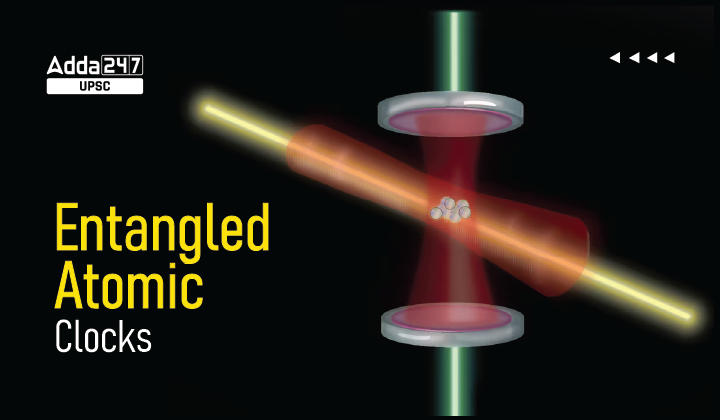Table of Contents
Entangled Atomic Clocks- Relevance for UPSC Exam
General Studies III- Awareness in The Fields Of It, Space, Computers, Robotics, Nano-Technology, Bio-Technology, Pharma Sector & Health Science.

In News
For the first time, scientists at the University of Oxford have been able to demonstrate a network of two entangled optical atomic clocks.
- The high-precision atomic clocks and quantum entanglement have been achieved altogether.
- This means the inherent uncertainty in measuring their frequencies simultaneously is highly reduced.
What are Atomic Clocks?
- An atomic clock is a clock that uses the resonance frequencies of atoms as its resonator.
- Cesium is incredibly accurate at timekeeping and is used in atomic clocks.
Entanglement
- Entanglement is a quantum phenomenon in which two or more particles become linked together so that they can no longer be described independently, even at vast distances.
- This is the key to reaching the fundamental limit of precision that’s determined by quantum theory.
- Previous experiments have demonstrated that entanglement between two atomic clocks in the same system can be used to improve the quality of measurements.
- This is the first-time researchers have been able to achieve this between clocks in two separate remotely entangled systems.
Use clocks to navigate in space
- To determine a spacecraft’s distance from Earth, navigators send a signal to the spacecraft, which then returns it to Earth.
- The time the signal requires to make that two-way journey reveals the spacecraft’s distance from Earth, because the signal travels at a known speed (the speed of light).
- While it may sound complicated, most of us use this concept every day. The grocery store might be a 30-minute walk from your house.
- If you know you can walk about a mile in 20 minutes, then you can calculate the distance to the store.
- By sending multiple signals and taking many measurements over time, navigators can calculate a spacecraft’s trajectory: where it is and where it’s headed.
Need atomic clocks
- To know the spacecraft’s position within a meter, navigators’ need clocks with precision time resolution — clocks that can measure billionths of a second.
- Navigators also need clocks that are extremely stable.
- Stability refers to how consistently a clock measures a unit of time; its measurement of the length of a second, for example, needs to be the same (to better than a billionth of a second) over days and weeks.
What is an oscillator in a clock?
- Most modern clocks, from wristwatches to those used on satellites, keep time using a quartz crystal oscillator.
- These devices take advantage of the fact that quartz crystals vibrate at a precise frequency when voltage is applied to them.
- The vibrations of the crystal act like the pendulum of a grandfather clock, ticking off how much time has passed.
Role of atoms in the clocks
- By space navigation standards, quartz crystal clocks aren’t very stable.
- After only an hour, even the best-performing quartz oscillators can be off by a nanosecond (one billionth of a second).
- After six weeks, they may be off by a full millisecond (one thousandth of a second), or a distance error of 185 miles (300 kilometers).
- That would have a huge impact on measuring the position of a fast-moving spacecraft.
- Atomic clocks combine a quartz crystal oscillator with an ensemble of atoms to achieve greater stability.



 TSPSC Group 1 Question Paper 2024, Downl...
TSPSC Group 1 Question Paper 2024, Downl...
 TSPSC Group 1 Answer key 2024 Out, Downl...
TSPSC Group 1 Answer key 2024 Out, Downl...
 UPSC Prelims 2024 Question Paper, Downlo...
UPSC Prelims 2024 Question Paper, Downlo...
